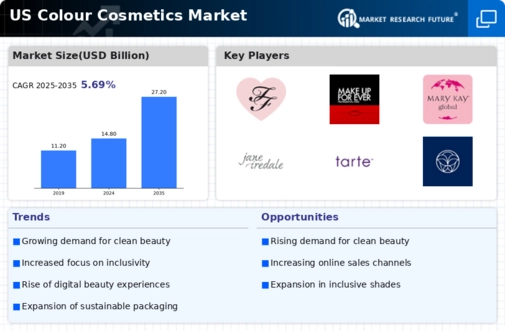The colour cosmetics market is currently characterized by a dynamic competitive landscape, driven by innovation, sustainability, and digital transformation. Major players such as Estée Lauder (US), L'Oreal (FR), and Coty (US) are actively shaping the market through strategic initiatives. Estée Lauder (US) has positioned itself as a leader in luxury cosmetics, focusing on high-quality products and personalized customer experiences. L'Oreal (FR), on the other hand, emphasizes inclusivity and sustainability, aiming to cater to a diverse consumer base while reducing its environmental footprint. Coty (US) is leveraging partnerships and acquisitions to enhance its portfolio, particularly in the fragrance and skincare segments, thereby broadening its market reach. Collectively, these strategies contribute to a competitive environment that is increasingly focused on consumer-centric innovation and sustainability.
In terms of business tactics, companies are localizing manufacturing and optimizing supply chains to enhance efficiency and responsiveness to market demands. The competitive structure of the market appears moderately fragmented, with several key players holding substantial market shares while also facing competition from emerging brands. This fragmentation allows for a variety of consumer choices, but also necessitates that established companies continuously innovate to maintain their market positions.
In October 2025, Estée Lauder (US) announced a significant investment in a new manufacturing facility in Texas, aimed at increasing production capacity for its popular makeup lines. This move is strategically important as it not only enhances supply chain efficiency but also aligns with the company's commitment to sustainability by utilizing eco-friendly manufacturing practices. The facility is expected to create approximately 500 jobs, further solidifying Estée Lauder's presence in the US market.
In September 2025, L'Oreal (FR) launched a new digital platform that integrates augmented reality (AR) technology, allowing consumers to virtually try on makeup products before purchasing. This initiative reflects L'Oreal's focus on digital transformation and consumer engagement, potentially increasing conversion rates and enhancing customer satisfaction. By leveraging technology, L'Oreal aims to create a more personalized shopping experience, which is becoming increasingly vital in today's competitive landscape.
In November 2025, Coty (US) entered into a strategic partnership with a leading tech company to develop AI-driven beauty solutions. This collaboration is expected to enhance product development and marketing strategies, allowing Coty to better understand consumer preferences and trends. The integration of AI into Coty's operations signifies a forward-thinking approach that could redefine how beauty products are marketed and sold, positioning the company for future growth.
As of November 2025, current trends in the colour cosmetics market include a strong emphasis on digitalization, sustainability, and the integration of advanced technologies such as AI. Strategic alliances are increasingly shaping the competitive landscape, enabling companies to pool resources and expertise to drive innovation. Looking ahead, competitive differentiation is likely to evolve from traditional price-based competition to a focus on innovation, technology, and supply chain reliability. Companies that can effectively leverage these trends will likely secure a competitive edge in the ever-evolving market.






















Leave a Comment